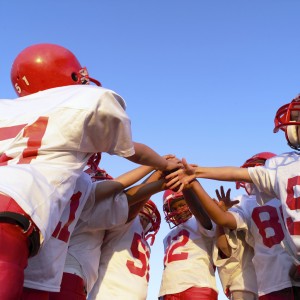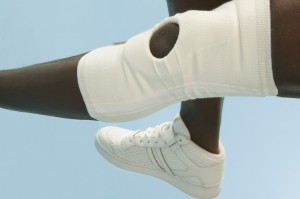The knee is a complex joint that is vulnerable to a variety of injuries. The knee is made up of the femur (the thigh bone), the tibia (the shin bone), and the patella (the knee cap). The femur rotates on the upper end of the tibia and the patella fits on the end of the femur.
There are also many large ligaments that connect the bones of the knee and help control knee motion. The meniscus is a wedge of cartilage that serves as a cushion between the femur and tibia and also absorbs shock. Many football athletes experience injuries to these knee structures.
Ligament Injuries
Football players frequently injure one or more of the knee ligaments. These ligaments include the anterior cruciate ligament (ACL), the posterior cruciate ligament (PCL), the medial collateral ligament (MCL), and the lateral collateral ligament (LCL).
- ACL Injury – When an athlete changes direction rapidly, lands wrong from a jump, or simply slows down when running, the ACL could tear. With this injury, knee swelling immediately occurs and walking is painful. The knee may have loss of range of motion and tenderness with an ACL injury. Treatment for this type of injury depends on the degree of tear to the ligament, whether or not there are other associated injuries, and how much physical demand the patient puts on their knee. Sometimes, the orthopedic specialist needs to operate to repair a complete tear of the ACL. Recovery is measured in months, rather than weeks for this type of injury.
- MCL Injury – The MCL is generally injured from a direct blow to the outside portion of the knee. The ligament is torn or stretched when the foot is planted firmly on the ground and a sideways force hits the knee. An injured MCL causes pain, difficulty walking, and tenderness. Therapy involves the use of a knee immobilizer, rest, ice applications, compression with a support bandage, and frequent knee elevation. Surgery is only necessary for severe tears of the MCL.
- PCL Injury – The PCL is injured when a football player receives a blow to the front aspect of the knee or makes a simple misstep on the turf. Most PCL tears and injuries will heal with conservative treatment. An injured PCL leads to pain with walking, instability, and swelling of the knee. Surgery may be necessary with complete tearing and extensive damage to the PCL.
LCL Injury – The LCL is the least likely ligament to be injured during football activities. When severe force is applied to the inside of the knee, a LCL injury could occur. Symptoms include pain, swelling, weakness, tenderness, and discomfort to the outside of the knee. Treatment involves the RICE method, anti-inflammatory medications, and immobilization. Surgery to reattach the ligament to the bone is sometimes required.
Cartilage Injuries
Torn Cartilage – Most of the time, the meniscus is the cartilage that is torn during a football game. This rubbery, tough structure serves as a shock absorber during athletic activities. The meniscus tears with cutting, decelerating, pivoting, twisting, or from being tackled. Most torn meniscus injuries cause gradual pain and swelling, worse with climbing steps or uphill.
Not all meniscus tears require surgery, but frequently the damage can only be repaired through an operation.
Fractures
The patella can break if the football player falls directly onto it or receives a direct blow in that area. If the bone is fragmented, surgery will be required for repair. If the bone is in appropriate position, the orthopedic specialist may prescribe an immobilizer and rest for the injury.
The head of the fibula on the outside area of the knee joint is easily fractured from direct blows or as part of an injury to the lower leg. If the bone is not out of alignment, immobilization and conventional therapy will treat the injury.
Sometimes, however, the fibula fracture is complex and requires surgical repair. With jumping types of injuries, the tibia bone can be damaged. If the fracture occurs in the tibial plateau, surgery is often necessary.
Bursa Inflammation
Bursa inflammation is also called ‘housemaid’s knee’ or prepatellar bursitis and is the result of repetitive kneeling or crawling on the knees. The space between the kneecap and skin is called the bursa and it becomes irritated and fills with fluid. Bursa inflammation is a common type of knee injury of football players. Treatment includes using anti-inflammatory medications and rest. Occasionally the bursa needs to be drained for resolution of the problem.
Patellar Injuries
The patella can dislocate if it receives a direct blow. The blow can force this bone toward the outside area of the knee. Most dislocations of the patella easily return to normal alignment by simply straightening out the knee. However, some patella dislocations are serious and require surgery.
Also, patella-femoral syndrome is inflammation to the underside of the patella. This condition causes localized pain, which is worse with running and walking down stairs.
Treatment involves strengthening exercises, the use of ice therapy, and anti-inflammatory medications. Severe cases of this disorder require arthroscopic surgery to remove the damaged cartilage and realign parts of the quadriceps muscle.
Muscle and Tendon Strain
Most strains of the knee are treated with rest, ice therapy, elevation, and compression. Crutches help with walking, and the doctor may order an anti-inflammatory medication. These injuries are often the result of hyper-extension involving the hamstring muscles or hyperflexion causing the quadriceps to be injured.
If the patellar or quadriceps tendon is ruptured, there is inability to extend the knee. Surgery is necessary to repair this type of injury.

 Football is a rough sport, regardless of the protective equipment worn. Injuries go with the territory when it comes to this sport. Because the players are big, the game is fast, and the nature is physical, football injuries are quite common. In the United States alone, there are an estimated 1.2 million football injuries each year, and around 50 percent of these injuries occur during training.
Football is a rough sport, regardless of the protective equipment worn. Injuries go with the territory when it comes to this sport. Because the players are big, the game is fast, and the nature is physical, football injuries are quite common. In the United States alone, there are an estimated 1.2 million football injuries each year, and around 50 percent of these injuries occur during training.  Knee dislocations are uncommon orthopedic injuries and occur when the bones that form the knee are out of place. A knee dislocation involves damage to multiple ligaments, resulting in severe instability. Knee dislocations also often occur with injuries to the meniscus and the nerves and vessels that surround the knee. A knee dislocation occurs when the femur (thigh bone) and tibia (shin bone) lose contact with each other. In some injuries, the knee cap (patella) also is disrupted. Most knee dislocations are the result of high-energy traumatic injury, such as a motor vehicle accident or severe fall or impact.
Knee dislocations are uncommon orthopedic injuries and occur when the bones that form the knee are out of place. A knee dislocation involves damage to multiple ligaments, resulting in severe instability. Knee dislocations also often occur with injuries to the meniscus and the nerves and vessels that surround the knee. A knee dislocation occurs when the femur (thigh bone) and tibia (shin bone) lose contact with each other. In some injuries, the knee cap (patella) also is disrupted. Most knee dislocations are the result of high-energy traumatic injury, such as a motor vehicle accident or severe fall or impact.